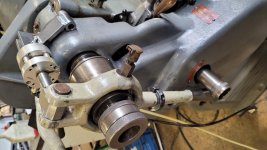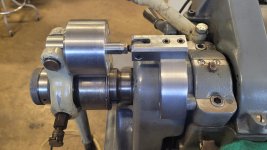So I have tried to make my lever style 5C collet closer pneumatic. So far this is what I have, it opens and closes fine and runs, but there must be tension/force somewhere I had not accounted for. I remove pressure from the cylinder while running, but while trying to drill a 3/8 hole in mild steel the lathe slows to a stop. Best I can figure is I need an added angle of movement on the fixed end.
Anyone done something like this before? Hadn't seen any when I searched the forum. If you have could you share how you did it, or what your thoughts are on my setup?
Also of note: Trying to put as few holes in the lathe as possible. Only one so far...



Anyone done something like this before? Hadn't seen any when I searched the forum. If you have could you share how you did it, or what your thoughts are on my setup?
Also of note: Trying to put as few holes in the lathe as possible. Only one so far...










